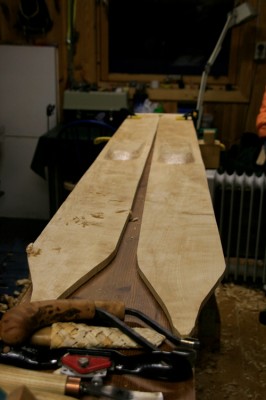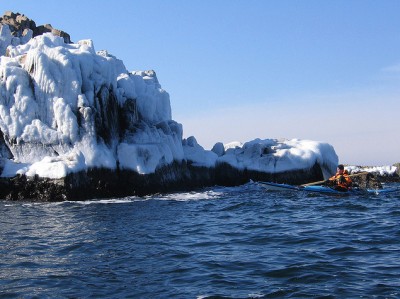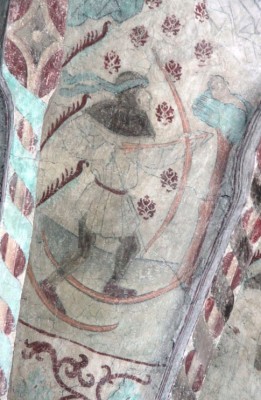Last year archaeologists found a very old ski with its ski-binding intact. Now the time has come to reconstruct the find
Climate change is causing the glacier in Reinheimen National Park in Norway to melt, yielding lost artefacts from the Norwegian Iron and Viking age. So-far archaeologists have uncovered more than 2000 artifacts from the glacier in Oppland.
This summer archaeologists found a very old ski, dated to around AD 700. What makes this find especially valuable is the binding, which was intact.
 The ski was made of birch and measures 172 cm long and14.5 cm wide, making it somewhat akin to present day free riding skis, also called big mountain skis. The intact binding is at the back and consists of a wicker pulled through a hole in a slightly elevated platform and fastened with strings of leather around the back of the foot. This tells us a lot of how they manoeuvred, says the archaeologist Espen Finstad. He adds that the ski was probably used by a hunter moving across the glacier, tracking reindeers or other prey.
The ski was made of birch and measures 172 cm long and14.5 cm wide, making it somewhat akin to present day free riding skis, also called big mountain skis. The intact binding is at the back and consists of a wicker pulled through a hole in a slightly elevated platform and fastened with strings of leather around the back of the foot. This tells us a lot of how they manoeuvred, says the archaeologist Espen Finstad. He adds that the ski was probably used by a hunter moving across the glacier, tracking reindeers or other prey.
Other skis have been found in Norway and Sweden, some of which have been dated even earlier. However, the ski from Reinholmen is the only one found with intact binding; worldwide only one find predates this.
Currently local craftsmen from Garmo in Lom are reconstructing the ski in order to try the design out during winter. The point of the wide modern skis is that they glide on top of the snow. The question, the archaeologists wish to answer, is whether the ski from Reinheimen has the same quality.
The Sagas and Cronicles

To be an adroit skier was not only important in daily life, but also considered an important and status-filled ability. In the Norwegian royal sagas skiing is mentioned several times as an important skill. Most famous, however, is the story about Palnatoke (alias the Norwegian hero, Heming Aslaksson alias the later Wilhelm Tell). About this mythical hero it is told by Saxo Grammaticus and in in the Icelandic Saga of the Jomsvikings that he was pagan who founded Jumla on the Baltic. He was a mighty warrior and a very proficient skier. The story Saxo tells is that:

“Harold [Bluetooth] boasted of his proficiency in that technique, which the Finns use when passing through snow-covered forests; Toke then dared to brag about his own talents and compare them to those of the king. This forced Toke to prove his capabilities on the mountain of Kullaberg. But what he lacked in practice, he made up for in courage. He went to the upmost top of the mountain and with smooth planks beneath his feet and only a slender staff to support him, set off at a terrifying speed. In breakneck fashion he hurdled down on his skis across sharp rocks; nevertheless he succeeded cold-bloodedly to control them. Neither the great danger nor panic of any art kept him from keeping erect. Any other would have been terrified by the great chasm before even venturing upon this experiment. At the end the skis splintered against the rocks and he was hurled into the air, but this in fact saved his life… he hit the cliff at great speed, the skis broke and thus he ended the run in a safe manner. If not great boulders and deep holes had been in his way, he would for sure have ended up in the sea below the cliff. Here some sailors picked him up and in his hatred to the king he did nothing to slay the rumours that he had ended up worse than was the case… he decided then to shift his allegiance to the son of the king, Sven [Forkbeard]” (Saxo Grammaticus, 10: 7, 4. From c 1190 -1200.)
It is worth remembering that Saxo was part of the entourage of the Archbishop Absalon and had probably sailed past Kullen (Kullaberg) any number of times. Passing by he seems to have wondered what was the truth behind the fairy-tale about Palnatoke. An echo of these reflections may obviously be found in this vignette from his grand chronicle, Gesta Danorum (Acts of the Danes).
SOURCE:
Rekonstruksjon av Reinheimskia
PHOTOS:
READ MORE:
Iron Age Tunic found in the glacier

